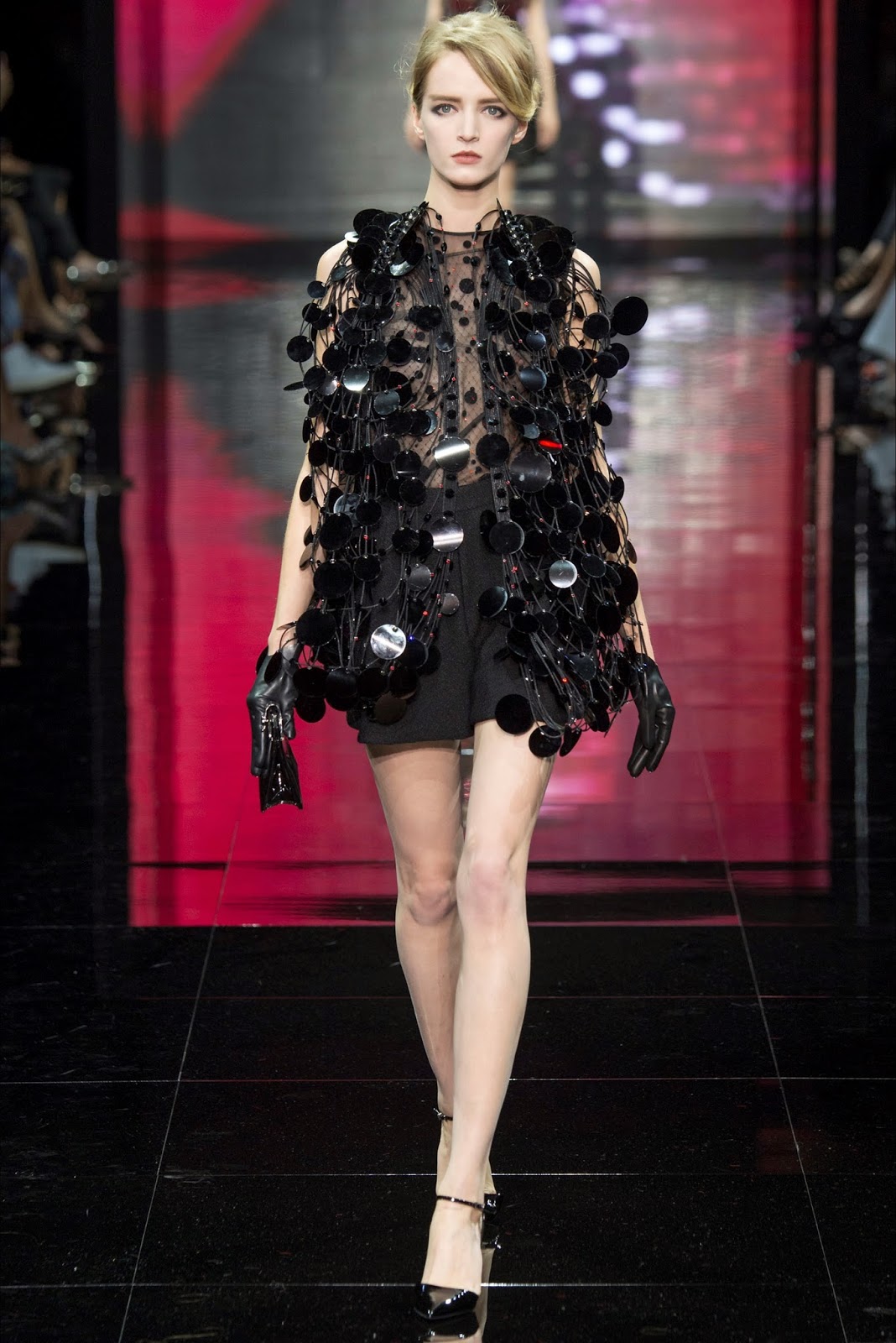Paris Couture Review: Armani Privé, Jean Paul Gaultier, Valentino
PARIS — The winter couture season drew to a close just after Brazil’s dreams of World Cup glory were crushed by Germany and just before everyone found out whether Argentina or the Netherlands would be the victor. People were on the edge of their catwalk benches. Not everything has a happy ending.
Indeed, you’d think the contrast between the most democratic of sports and the most elite of fashion arts, the roar of the crowd and the hush of the salon, might have culminated in some of the usual existential garment-rending and why-are-we-here questioning — Is couture necessary? Don’t you get more life lessons on the field? — but instead a kind of quiet self-confidence has permeated the collections, on the final day as the days before.
They are what they are. Like it or go watch soccer. Better yet: like it AND go watch soccer. They are both a kind of national sport, after all.
Witness Giorgio Armani’s joke backstage pre-show, as he explained his choice of ... shorts! They were shown with almost every garment in the opening group of the Privé show, from swingy trapeze jackets to narrow peplumed numbers with gently fluted sleeves. “My clients, no matter what age they are, tend to have nice legs,” he said. “So I thought we should show them off.”
Well, yes — and there’s a new generation-a-buyin’. (See, for example, the teenage actress Chloë Grace Moretz in the front row.) Perhaps it’s time to take them into consideration.
Edited down to a rigorous palette of red, white and black (inspired by a lacquer Chinese box), a graphic choice reflected in similar prints from polka dots to Mondrian grids and embroidered squares; eschewing fur in favor of fringed organza; and restrained in its use of crystal (though a little indulgent in the tiers-of-tulle department), this was Mr. Armani’s simplest collection in a long time, and that was a good thing. Evening gowns were gently flickering columns of flame.
It did not feel forced, just as, in a very different kind of way, Elie Saab’s parade of luminous lace and silk extravaganzas, segueing from smoke to white flame via a rose glow and glinting with pearls, diamonds and metallic embroidery, was very Elie Saab. (It made the many ladies in his front row look happy anyway; if you want to know who’s wearing these clothes, there’s your answer.)
Ditto Maison Martin Margiela’s ingenious exploration of couture’s “exquisite corpse,” which sounds vaguely gruesome but turned out to be smartly gorgeous. It was a novel interpretation of the Artisanal collection’s mission to reuse, recycle and reinvent: left-over couture textiles and scraps from an original Poiret opera coat into gilets; silk 1950s Japanese bomber jacket into gowns; even old French francs sewn on sweeping underskirts of chiffon. When you stop trying to justify your existence and simply perform to the best of your ability, the end result can have a surprising ... kick.
It is a lesson, unfortunately, that Jean Paul Gaultier does not seem to have absorbed; witness his reliance on the crutch of “theme” — this season a sort of Marilyn Manson-meets-Morticia Addams-meets-True Blood fantasia of black satin, red crystal and gold chains that hid the elegance of his organza trench coats with millefeuille collars, his sinuous velvet columns and sweatshirts de luxe, under a veil not of tulle but of camp
Such overlay is just a distraction; a sleight of hand seemingly used to cover a lack of faith in the real content. And it’s simply not necessary, as Maria Grazia Chiuri and Pierpaolo Piccioli, the creative directors of Valentino, proved.
“We love couture,” they both said, practically giggling with glee, before the show, and it’s not because they love the idea of really, really, exclusive clothes but because handwork allows them to do things they could never do anywhere else, like distill clothing to its essence.
They wanted, they said, to explore the idea of how you work “memory and the future together,” so they took toga dressing and abstracted it until one rectangle of pastel wool wrapped around the body only to fall in perfectly calibrated waves down the side. Corsetry itself was transformed into the idea of corsetry via black leather strips built into the side seams of monastic gowns just under the arms, which could then be crisscrossed and tied around the waist as desired by the wearer. Overt adornment (crystals, chunky embroidery) was rejected in favor of intarsia techniques that appliquéd designs directly on a garment, so a white minidress of basket-woven chiffon had a black leather fleur-de-lis seemingly sprouting from the hem, and oily feathers were grafted onto chiffon to make a cape with the nonchalance of a sweater.
In other words, they took an extremely complicated approach and made it look easy. Which brings them (and all of us) to the next stage of the game.
Ready-to-wear. It starts in September.
Giorgio Armani Privé
Elie Saab Winter 2014-2015 Couture
Maison Martin Margiela
Winter 2014 - 2015 Couture
PHOTOS BY: Nowfashion.com
“Simplicity is the ultimate sophistication.”
—Leonardo da Vinci
Take care Fashionistas, let's meet here real soon and continue to 'Figure our The Fashion Trend'. XOXO
















































































































































0 comments:
Post a Comment